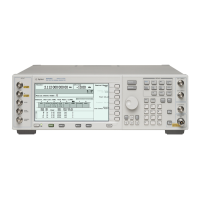52 Chapter 3
Basic Operation
Configuring the RF Output
7. Press Freq Offset > 1 > MHz.
This enters a 1 MHz offset. The FREQUENCY area displays 2.000 000 00 MHz, which is the
frequency output by the hardware (701 MHz) minus the reference frequency (700 MHz) plus the offset
(1 MHz). The OFFS indicator is activated. The frequency at the RF OUTPUT connector is still
701 MHz.
Setting the RF Output Amplitude
1. Press
Preset.
2. Observe the AMPLITUDE area of the display.
The display reads the minimum power level of the signal generator. This is the normal preset RF output
amplitude.
3. Press
RF On/Off.
The display annunciator changes from RF OFF to RF ON. The RF signal is now being output at the
minimum power level at the RF OUTPUT connector.
4. Press
Amplitude > –20 > dBm.
This changes the amplitude to −20 dBm. The new −20 dBm RF output power is now displayed in the
AMPLITUDE area of the display and also in the active entry area.
Amplitude is still the active function until you press another front panel function key. You can also
change the amplitude using the up and down arrow keys and the knob.
Setting the Amplitude Reference and Amplitude Offset
The following procedure sets the RF output power as an amplitude reference to which all other amplitude
parameters are relative. The amplitude initially shown on the display will be 0 dB (the power output by the
hardware minus the reference power). Although the display changes, the output power does not change. Any
subsequent power changes are shown as incremental or decremental to 0 dB.
1. Press
Preset.
2. Press
Amplitude > –20 > dBm.
3. Press
More (1 of 2) > Ampl Ref Set.
This activates the amplitude reference mode and sets the current output power (−20 dBm) as the
reference value. The AMPLITUDE area displays 0.00 dB, which is the power output by the hardware
(20 dBm) minus the reference value (−20 dBm). The REF indicator is activated and the
Ampl Ref Off On
softkey has toggled to On.

